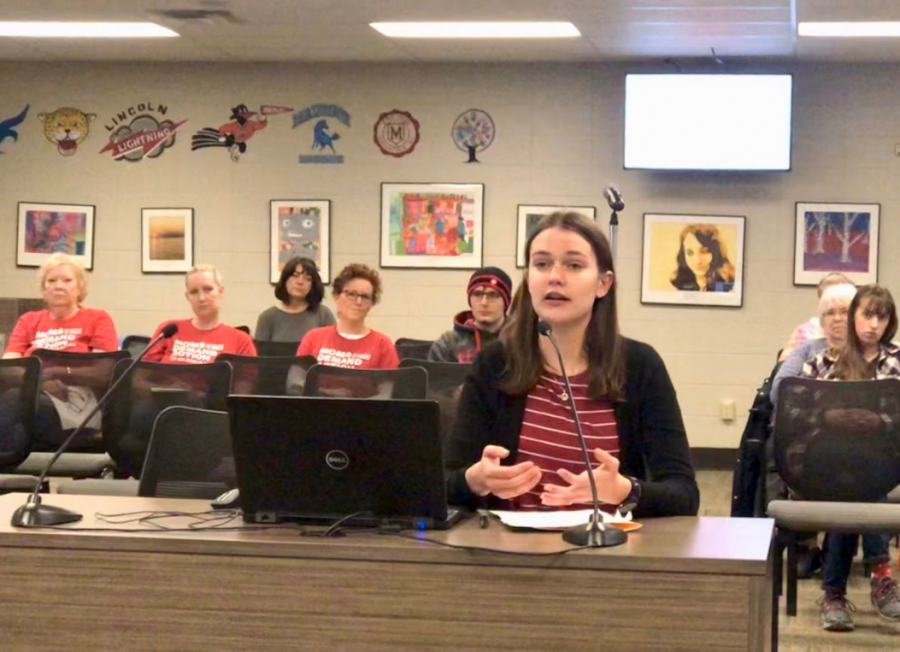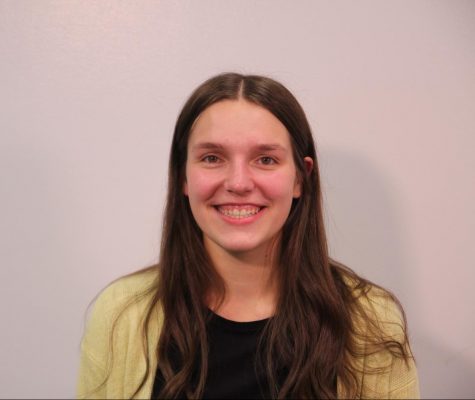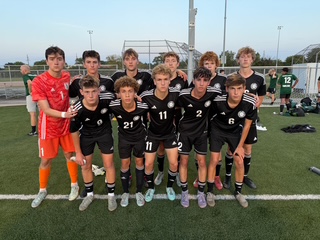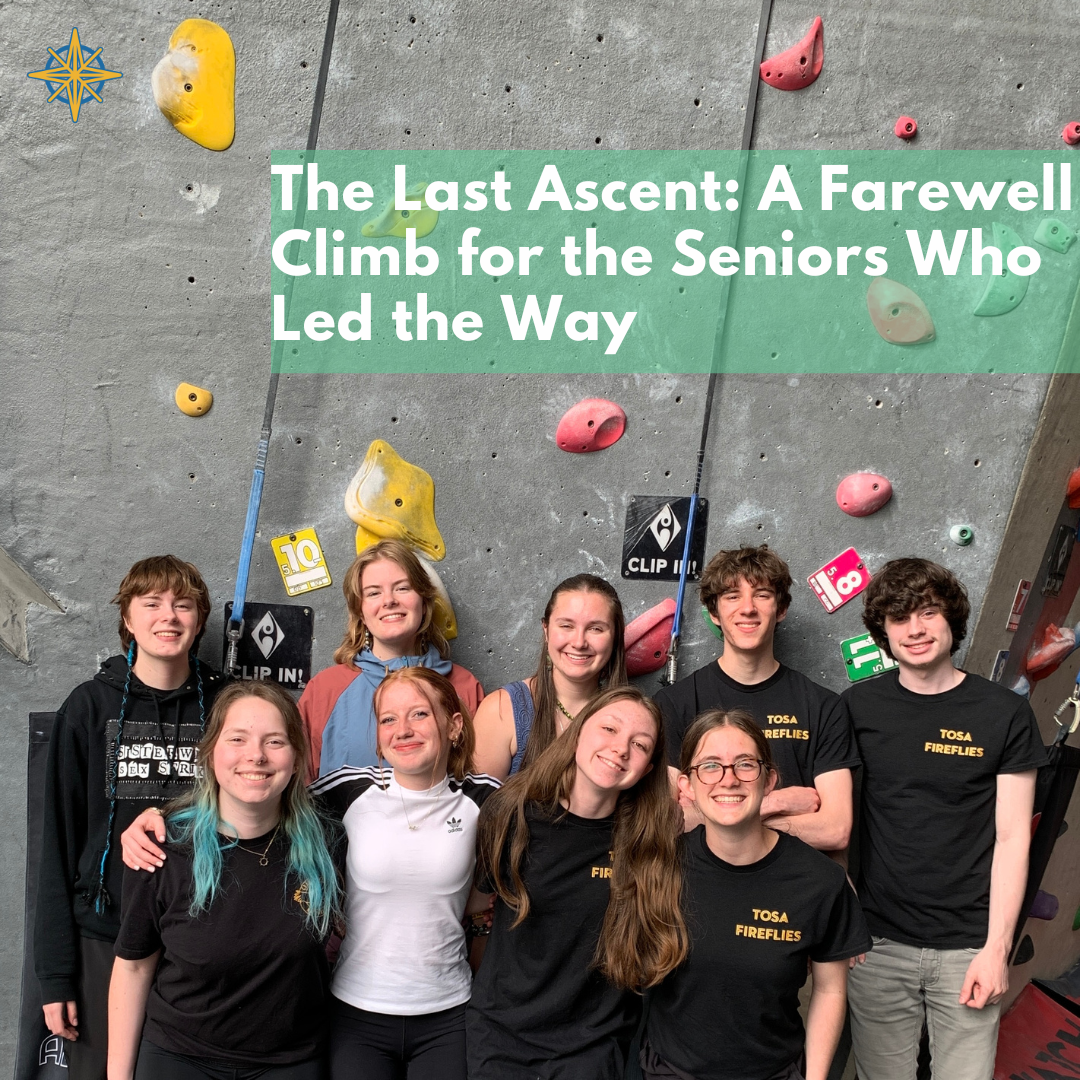School Board Focuses on Mental Health at Meeting
Wauwatosa East Junior Sarah Gifford presents her slideshow at the school board meeting.
January 31, 2020
Wauwatosa East Junior Sarah Gifford presented a slideshow on school shootings and mental health at the Wauwatosa School Board meeting on January 27th.
The presentation by Gifford was a part of a larger focus on mental health in the district at the meeting. Another presentation was given as a report on the district’s mental health services and staffing. The School Board also approved the Legislative Advocacy Committee’s Mental Health Resolution calling on the state legislature and Governor Tony Evers to allocate sufficient funds to Wisconsin school districts relating to mental health and to address the shortage of mental health professionals in the state qualified to assist with the needs of school-age children.
Gifford’s presentation was based on possible solutions to issues associated with school shootings and mental health as well as on the responses to a survey Gifford sent to East and West staff and students. 407 student and 100 staff responses were recorded in the survey.
“Even when I was reading the responses, I didn’t realize how much of an issue mental health and school shootings were. Knowing that students’ and teachers’ needs weren’t currently being met really bothers me and I wanted to show people that they should be met,” Gifford said.
Gifford originally sent out a small survey to her peers to support an opinion editorial she chose to write on school shootings for her AP Language and Composition class. She received 10 responses but hoped for more and emailed Wauwatosa School Board Vice President Shawn Rolland. Consequently, Rolland offered the opportunity for Gifford to present the results of a larger survey to the school board at a meeting.
The survey was open January 20th through the 25th, corresponding with finals week for students and staff at Wauwatosa East and West High Schools. School Board member Leigh Anne Fraley was surprised at the number of responses.
Following Gifford’s presentation, Fraley said, “I think you got a great response rate not just from students but from staff in a very short period of time in a very busy week with finals. I really was shocked by that response.”
Two separate surveys were provided for staff and students.
However, “teachers and students were asked similar questions” according to Gifford.
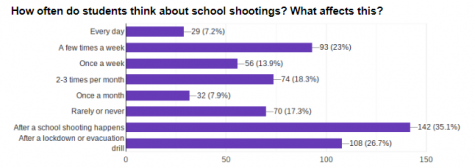 One question posed to students asked, “How often do students think about school shootings?”
One question posed to students asked, “How often do students think about school shootings?”
35.1% of students selected “after a school shooting happens,” which was the most popular response. 26.7% answered, “after a lockdown or evacuation drill.” 23% selected “a few times a week.” The least popular response included “every day” with 7.2% of students selecting it.
One student response elaborating on why they selected the frequency they did stated, “Whenever there’s a new one in the news, my mind automatically thinks ‘That could be anywhere. That could be us.’”
Another question posed to staff and students asked, “How often should we have drills and what type?”
The largest percentage of students, 46.3%, thought drills should occur every month. 37.1% thought these drills should be “open discussion of what to do in a situation.”

Similarly, the largest percentage of staff, 39%, also thought drills should consist of “open discussion of what to do in a situation.” However, 37.8% of staff thought drills should occur “once a semester.”

Another question asked, “What do you think the School Board should do to address school shootings? How would this be implemented?”
One student response stated, “Give better mental health support and make it clear that there is someplace for kids to go to talk to someone about what is wrong.”
Some staff had similar ideas to the students.
One staff member stated the school board should “fund full-time social workers and school psychologists at the Middle and High schools to help prevent the build-up of frustration or anger in students who could become shooters.”
Other staff members weren’t sure how to approach the problem.
One staff member responded, “No idea. It’s a sad commentary on our society.”
Both students and staff were also asked: “Would you be in support of high schools having therapist(s) on campus to talk to students on an appointment basis?”
The majority of students, 76.7%, said they would be in favor. 79% of staff said they also would be in favor. A student elaborated “I feel like it would be extremely helpful, especially to those who can’t afford to see a therapist outside of school.
Some staff had similar opinions.
One staff member stated, “So many of my students deal with mental health issues that affect their work in class.”
Another staff member recognized the differences in their experiences in high school in comparison to those today.
“I think students today have a lot more anxiety than I did when I was their age,” one staff member said.
Gifford thinks her presentation and the information she provided helped to solidify for the school board that these problems need to be further addressed.
“I was really shocked by a lot of the survey results. I knew that these things were problems, but the problem is so much bigger than anyone realizes. Reading over the results, students and teachers have a lot of opinions and they want change and don’t know what to do,” Gifford said.
Gifford, like many survey respondents, believes open discussion regarding dills and situations would be beneficial.
“I would love to spend that time after the drills and just 10 minutes and say ‘what do you guys feel about this’ because I think that will really open up the conversation,” Gifford said. “I think at this point we just need to realize this is the reality and we need to face it head-on.”
Student Representative on the School Board and Wauwatosa East student Cameron Clark agrees with Gifford.
“The discussion afterward is so key to me,” Clark said.
Clark explained teachers often go back to class as normal after a drill although the class is often “more talkative afterward thinking about what we would do.”
Clark believes making time for discussion after drills would be calming.
“I think it would be a comfort to me and I’m sure many other people,” Clark said.
Additionally, Gifford believes that drills should be more diverse. She said she’s never had a drill during passing time or lunch.
“I don’t even know where I would go for a drill if I was in the bathroom. There are so many different situations that we don’t practice and talk about that are possible,” Gifford said.
Gifford also believes an important solution is implementing therapists in the district.
Gifford stated that 20% of students responding to the survey stated they do not see a therapist but would like to.
Student representative and Wauwatosa West Senior Jalysa Runyan also believes therapists would be beneficial.
“I think the therapist would be a really good idea. I definitely think that a lot of kids would take that in and use it, even teachers too,” Runyan said.
Following Gifford’s presentation, Fraley stated that it tied well with the agenda for the rest of the meeting.
“We’re going to talk a lot about mental health tonight so it’s really nice to hear from a broader swath of students and faculty as well,” Fraley said.
Gifford’s presentation was followed by a presentation on the district’s mental health services and staffing by Director of Elementary Education Kristin Bowers, Director of Secondary Education Mark Carter as well as Wauwatosa East High School Social Worker and Mental Health Content Team Leader Sonja Phillips.
“We are busy all day every day. Students come in through friends and through families but there are many many students who don’t and don’t know about us,” Phillips said.
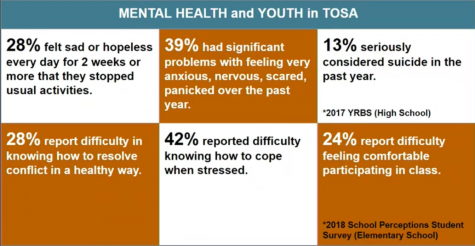 Clark agrees that some students go to student services for help but are not met with right away as the staff is constantly busy.
Clark agrees that some students go to student services for help but are not met with right away as the staff is constantly busy.
“Student services try their hardest. You get there and they’re busy and you’re just sitting there waiting for like 20 to 30 minutes and you’re missing class which is more stress and then you end up leaving,” Clark said. “They say ‘we’ll have them call you’ but most of the time that will never happen unless you go out of your way multiple times trying to reach out and get help.”
Wauwatosa School Board President Eric Jessup-Anger also believes the districts’ resources are in high demand but overwhelmed.
“We have staff doing everything they can. We’ve got teachers that are tired. Staff that are tired. All the way up feeling this weight is my observation. There’s a lot to manage,” Jessup-Anger said.
The district, like many other large school districts in Wisconsin, is facing challenges addressing the mental health needs of all students.
Wauwatosa Superintendent Phil Ertl recently attended a meeting between the state’s twenty largest school districts.
“It’s a clear struggle for every district that was there talking about the challenges and the funding and how to get the resources for the growing and growing need that’s taking place,” Ertl said.
Ertl doesn’t believe there is a district that is significantly more successful in regard to handling mental health.
“I didn’t get the sense that anyone was much further ahead. I didn’t get the sense anyone was much further behind,” Ertl said. “I would say we might be ahead because of the work auditing where we’re at.”
At the meeting, the school board also approved the Legislative Advocacy Committee’s Mental Health Resolution.
All attending School Board members, Eric Jessup-Anger, Sharon Muehlfeld, Shawn Rolland, Leigh Anne Fraley, and Michael Phillips, approved the resolution motioned by Rolland.
The legislative proposal is “in support of comprehensive school mental health and trauma-informed care legislation.”
However, some believe it isn’t the responsibility of a public K-12 school district to provide mental health care.
Fraley believes it is the responsibility of school districts.
“In order for us to educate students Maslow’s Hierarchy of Needs tells us that we actually have to address these exact issues so that students’ brains are actually ready to learn.”
Fraley believes this resolution is an important step in ensuring that students are able to learn.
“We are making this proposal because in order for kids to learn they have to have basic needs met. We’re not going to get to the vision of a graduate without mental health support,” Fraley said.
The resolution states “the Wauwatosa School District and all Wisconsin school districts lack the resources to employ enough mental health professionals to meet the growing needs of students.”
Furthermore, the resolution calls on the state legislature and Evers to allocate sufficient, sustainable and predictable state funding to school districts for various mental health-related uses.
The resolution states the American School Counselor Association (ASCA) recommendation for the counselor-to-student ratio is 1:125 students. The ratio for counselors to students among all public Wisconsin schools is 1:420. Within the Wauwatosa School District, the counselor ratio is 1:644 for elementary school students, 1:315 for middle school students, and 1:304 for high school students.
Similarly, the resolution states 1:250 is the National Association of Social Workers’ (NASW) recommendation for a social-worker-to-student ratio for an average school population. In all Wisconsin public schools, this ratio is 1:1,468. In the Wauwatosa School District, the ratio is 1:1,074 for elementary school students, 0 for middle school students, and 1:1,619 for high school students.
Wauwatosa School Board Vice President Shawn Rolland said, “We and everybody are way off of the recommendation.”
The National Association of School Psychologists (NASP) recommendation for a psychologist-to-student ratio is 1:500-700. In all Wisconsin public schools, the ratio is 1:967. In the Wauwatosa School District, the ratio is 1:1,639.
“We wish we had more staff. The numbers tell the story,” Rolland said.
A significant amount of Mental Health funding is grant-based from the state. The district can apply for these one-time grants.
However, Rolland said, “One-time money doesn’t pay for staff. You can’t pay a salary enduring. One time grants don’t really address the issue.”
The resolution also calls on the state legislature and Governor Evers to address the shortage of mental health professionals in the state able to address the needs of school-age children.
“Even if we wanted to go out and get more staff it’s going to be a competition,” Rolland said.
Jessup-Anger believes mental health is a topic the School Board and district need to continue to focus on.
“It’s a conversation we need to continue to have as a district to create environments where students can thrive, not just academically but their mental health and well being,” Jessup-Anger said.
He also believes this issue has been one of the highest concerns for many people related to the district.
Jessup-Anger said, “The number of staff, students, families that have talked to me about this, this issue is greater than any other since I’ve been on the board.”




